Mother’s Day traditionally marks the end of winter’s frost in the Midwest, making it one of the most important retail holidays for the region’s garden centers. Symbolizing gratitude, understanding and heartfelt emotion, hydrangeas are popular plants for their beauty – and also because they’re not “one and done.”
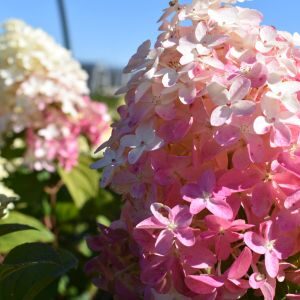
Quick Fire Fab® Panicle Hydrangea (Hydrangea paniculata)
Hydrangeas are deciduous perennial shrubs. They come in a vast variety of sizes and habits, and in diverse floral colors and styles with long bloom times. Once the growing season is over, hydrangeas keep on giving as dried floral arrangements from cutting gardens and as in-home decorations during the winter holidays. If displayed in containers during the growing season, move them in-ground once they’ve finished flowering to enjoy again next year.
Hydrangeas grow well in the Midwest and are bred for USDA Hardiness Zones 5 to 9. They require minimal care but do have some specific needs depending on the variety. Reference the accompanying plant tags for all the information you’ll need. For example, some hydrangeas prefer shade while others like sun. Some bloom on old wood and some on new. That’s important to know for pruning. You’ll want to prune hydrangeas on old wood once they’ve finished flowering, removing the weakest shoots. New wood hydrangeas can be cut back to the ground in late winter or early spring.
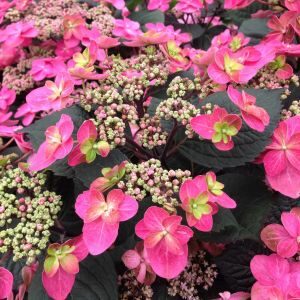
Tuff Stuff™ Red Mountain Hydrangea (Hydrangea serrata) – Proven Winners ColorChoice Photo
Here’s a handy reference if you’re confused about the types of hydrangeas.
- Hydrangea arborescens – Smooth flower heads. Blooms on new wood.
- Hydrangea macrophylla – Bigleaf, lacecap, mophead, snowball, hortensia and French bloom styles. Blooms on old wood.
- Hydrangea paniculata – Produces cone-shaped flowers. Blooms on new wood.
- Hydrangea quercifolia – Foliage resembles the leaves of oak trees. Blooms on old wood.
- Hydrangea serrata – Mountain variety is hardy to cold temperatures and compact in size. Blooms on old wood.
When planting hydrangeas, make sure the soil is loose and well-drained. Add a 2-inch layer of organic mulch so water seeps slowly down to the roots. For newly planted shrubs and during hot, dry spells, provide moisture in the morning everyday or every other day depending on dryness. When temperatures cool down, water deeply two to three times per week.
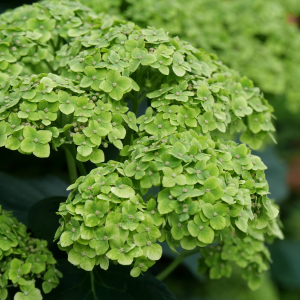
Invincibelle Sublime™ Smooth hydrangea (Hydrangea arborescens) – Proven Winners ColorChoice Shrub Photo
There’s no need to apply fertilizer if the soil is nutrient-rich. If it is necessary, fertilize in the spring with an all-purpose 10-10-10 or 12-4-8 ratio mix. Control the color bloom of Hydrangea macrophylla by adjusting the soil pH. Acidic soil with a 6.0 pH or lower produces blue flowers. Alkaline soil with a 7.0 pH or higher produces pink blooms.
Here are a few additional hydrangea varieties to consider planting this weekend, including two new 2023 introductions. Happy Mother’s Day!
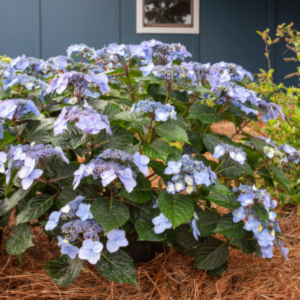
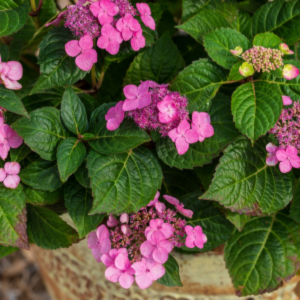
Pop Star® Bigleaf Hydrangea (Hydrangea macrophylla ‘Bailmacsix’) – In Blue and Pink – Photos courtesy of Bailey Nurseries
Pop Star® Hydrangea
Pop Star® Hydrangea is a new (and HOT) introduction for 2023! Place Pop Star® Hydrangea in part shade near a window so Mom can look out and enjoy it from spring through fall. Small and tidy at only 1½- to 3-feet tall and wide, it is perfectly planted in containers. In electric blue and bright pink, this hydrangea is a garden “star” with lacecap blooms. Adjust the soil pH for color preference. Place Pop Star® Hydrangea flowers on old and new wood, so leave the pruners in the shed. It has exceptional cold hardiness and disease resistance.

Puffer Fish® Panicle Hydrangea (Hydrangea paniculata) – Photo courtesy of Proven Winners
Puffer Fish® Hydrangea
Also new in 2023! Puffer Fish® Hydrangea is aptly named for its enormous, puffed-up white blooms. Clusters of flowers engulf the entire shrub from early summer to early fall. The shrub’s tight, compact habit is mature at 3 to 5 feet tall and wide. Stems are extremely sturdy to hold massive blooms upright. Blooms turn lime green as they age. As a final nod to the season, a fresh sprig of white flowers emerge at the tip. The panicle has an average height of about 5 to 6 inches, with an additional 1 to 1 ½ inches at the tip as it ages. Average diameter at the widest point of the inflorescence is about 5 to 8 inches. Puffer Fish® Hydrangea flowers on new wood. Cut it back to the ground in late spring or early fall. Plant in part sun to sun.
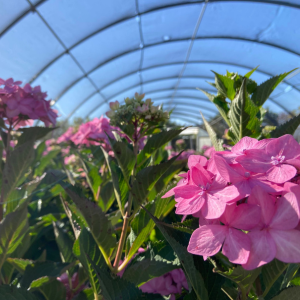
Let’s Dance Can Do!® Reblooming hydrangea (Hydrangea macrophylla x serrata)
Let’s Dance Hydrangea
Unlike other big-leaf hydrangeas, Let’s Dance Can Do!® Hydrangea creates flower buds up and down its stems. Lacecap flowers are strawberry pink in neutral/alkaline soils and lavender in acidic ones. This variety blooms on both old and new wood, so avoid pruning Let’s Dance Can Do!® Hydrangea or do so in spring when it’s obvious where new growth is emerging. This variety prefers part sun to sun and matures at 3 to 4 feet tall and wide.
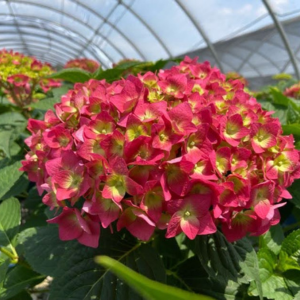
Summer Crush® Bigleaf Hydrangea (Hydrangea macrophylla ‘Bailmacfive’)
Summer Crush® Hydrangea
Rich, 3½ to 5 inch raspberry, ball-shaped mophead flowers celebrate summer all season long and then rebloom through fall. Summer Crush® Hydrangea flowers on old and new wood, so no pruning is needed. Mature height and width is about 3 feet. This variety works great in containers and in small spaces. Plant in partial shade.
Learn About Landscape Plants from Loma Vista Nursery
Loma Vista Nursery’s staff members are experts in the field. We love helping people learn and understand more about plants. Visit our plant catalog for information about shrubs, trees and perennial plants that are ideal for Midwest landscapes. To get answers to plant-related questions, send an email to sales@lomavistanursery.com or call (785) 229-7200.
Connect With Us
Stay current on our plant recommendations, growing tips and more by following us on social media.
